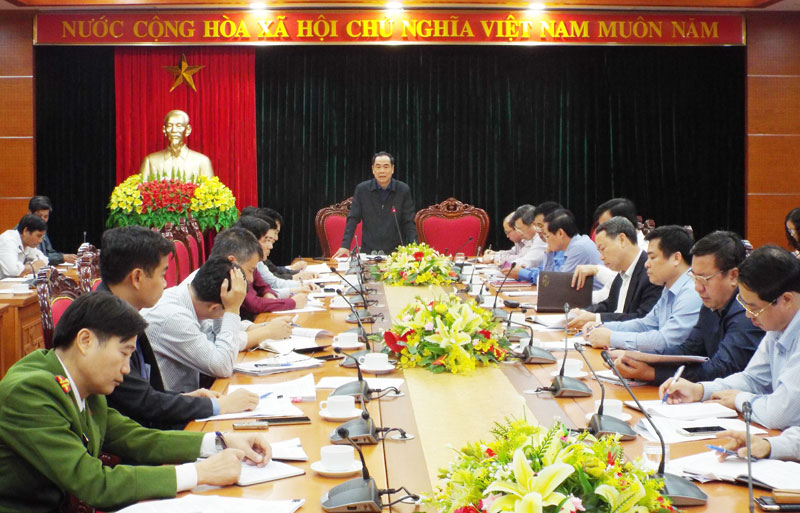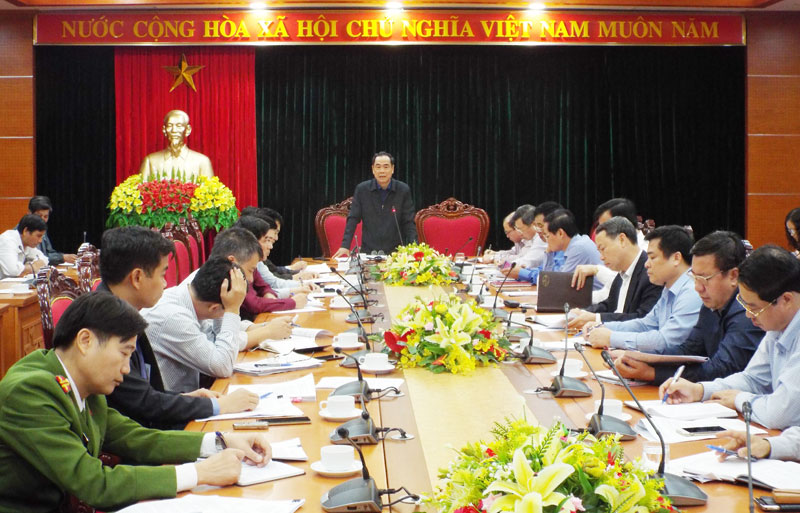
(HBO) - Chairman of the Hoa Binh People's Committee Nguyen Van Quang chaired a meeting to discuss solutions to manage markers of the safety corridor of Hoa Lac-Hoa Binh highway. Participating in the meeting were Vice Chairman of the provincial People's Committee Bui Van Khanh; representatives of the Vietnam Road Administration under the Ministry of Transport, departments and agencies; leaders of villages and hamlets along the highway as well as Ky Son district, Hoa Binh city and investors of Hoa Lac-Hoa Binh highway.

Chairman of Hoa Binh People’s Committee Nguyen
Van Quang concludes the meeting.
The Hoa Lac - Hoa Binh
road has a total length of 25.69km. The section passing Hoa Binh province is
19.32km long, which has been opened but has not yet been checked and taken over.
However, the protection of transport infrastructure has faced many difficulties.
In particular, many local households encroached on the land already cleared to
serve as the highway’s safety corridor, while the management of planning
markers of Hoa Lac-Hoa Binh highway has not been implemented. There is also a
lack of legal basis to define responsibilities of agencies and units in the
management of land inside the boundary of the Hoa Lac-Hoa Binh highway.
Speaking at the
meeting, Chairman of the provincial People's Committee Nguyen Van Quang said
that localities are already aware of the importance of the highway and its management
requirements. He requested the office of the provincial People's Committee and
advisory agencies to promptly build management regulations based on existing laws
and the real situation at the site, thus ensuring the regulations’ feasibility and
effectiveness. Investors should restore the road’s markers in January 2019, and
hand over to local authorities for management.
He also urged strengthening
the management of the current road corridor and the boundary markers of Hoa
Lac-Hoa Binh highway, adding that the status quo of land use must be maintained
while the change of land use purposes should be limited.
It is necessary to
review legal grounds for managing the planning of Hoa Lac-Hoa Binh highway, he
said, asking the provincial Department of Transport to soon issue brief and simple-to-understand
regulations on the management of Hoa Lac-Hoa Binh highway corridor to serve
communication purpose.
Chairman of the
provincial People's Committee emphasized that the heads of local governments
are responsible for the management of the Hoa Lac-Hoa Binh highway corridor./.
Hoa Binh province is undergoing a dynamic transformation amid Vietnam’s national digital transition. Building on Poliburo’s Resolution No. 57-NQ/TW on breakthroughs in science, technology, innovation, and national digital transformation, the province has rolled out a wide range of practical action plans. A standout initiative is the "Digital Literacy for All” movement, an effort to ensure that no one is left behind in the digital era.
Hoa Binh province is undergoing a dynamic transformation in the wake of the national digital transformation movement. Building on Resolution No. 57-NQ/TW of the Politburo on breakthroughs in science, technology, innovation, and national digital transformation, the province has implemented a wide range of practical action plans. A standout initiative is the "Digital Literacy for All” movement ambitious effort to ensure that no one is left behind in the digital age.
With a spirit of unity and proactive problem-solving, the Party Committee, the government and the people of Dong Lai Commune (Tan Lac District) have made great strides in implementing the resolutions of the 24th Party Congress of the commune for the 2020 - 2025 term. Focusing on leadership and practical actions, the commune has brought the Party’s resolutions into daily life, creating strong impacts and pushing the local development forward.
Amid the nationwide push for digital transformation, young people in Hoa Binh Province are stepping up as dynamic pioneers, applying technology to enhance Youth Union operations and expand the reach of youth-led initiatives. Through creativity and adaptability, Youth Union organizations at all levels have introduced a series of practical solutions, contributing to modern governance and community development.
In recent years, An Nghia commune, located in Lac Son district, has stepped up administrative reform, focusing on improving the quality and efficiency of its single-window service unit for receiving and processing administrative procedures. These improvements have helped create favourable conditions for local residents and organisations to handle administrative procedures, contributing to the commune’s broader socio-economic development.
The Prime Minister-approved master plan to develop the multi-use value of forests ecosystems through 2030, with a vision to 2050, aims to improve the management and sustainable use of forest resources, create jobs, increase incomes, and improve the living standards of ethnic minorities, people in mountainous and remote areas, forest workers and those living near forests.



